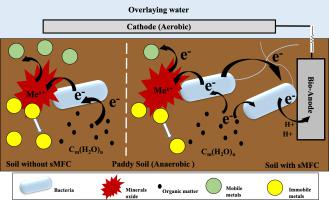Science of the Total Environment ( IF 8.2 ) Pub Date : 2020-11-27 , DOI: 10.1016/j.scitotenv.2020.143865 Williamson Gustave , Zhaofeng Yuan , Fuyuan Liu , Zheng Chen

|
Bioelectrochemical approaches offer a simple, effective, and environmentally friendly solution to pollutant remediation. As a versatile technology, although many studies have shown its potential in soil heavy metal(loid) remediation, the mechanism behind this process is not simple or well-reviewed. Thus, in this review we summarized the impacts of the microbial fuel cells (MFCs) on metal (loids) movement and transformation in the soil environment in terms of changes in soil pH, electromigration, and substrate competition between anode-respiring bacteria and the soil microbial community. Furthermore, the progress of MFCs in the fixation/removal of different elements from the soil environment is described. Hence, this review provides critical insight into the use of the MFC for soil metal(loid) bioremediation.
中文翻译:

微生物燃料电池修复土壤重金属(胶体)的机理与挑战
生物电化学方法为污染物修复提供了一种简单,有效且环保的解决方案。作为一项通用技术,尽管许多研究表明了其在土壤重金属(胶体)修复中的潜力,但该过程背后的机理并不简单,也未得到很好的评价。因此,在这篇综述中,我们从土壤pH值,电迁移以及阳极呼吸细菌与土壤之间的底物竞争方面总结了微生物燃料电池(MFCs)对土壤环境中金属(类)运动和转化的影响。微生物群落。此外,描述了MFCs从土壤环境中固定/去除不同元素的过程。因此,本综述提供了对使用MFC进行土壤金属(生物体)生物修复的关键见解。










































 京公网安备 11010802027423号
京公网安备 11010802027423号